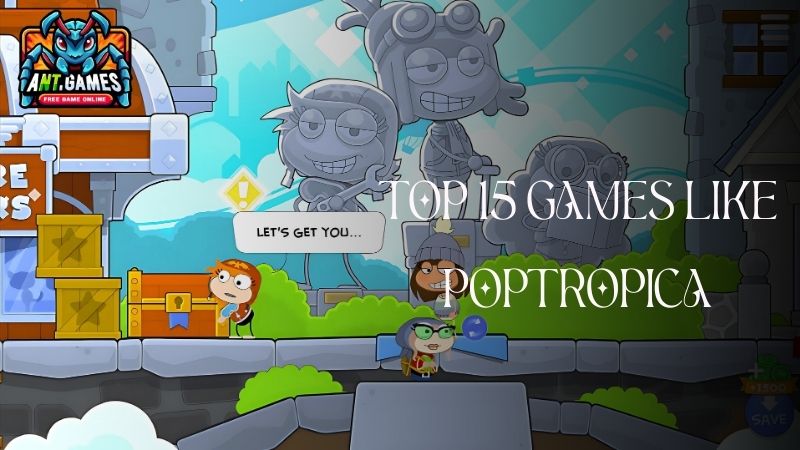HTML5 games are cross-platform, web-based games that players can enjoy seamlessly on various devices. These interactive applications leverage cutting-edge web technologies, including HTML5, CSS3, and JavaScript, to create responsive and engaging designs that function seamlessly across multiple platforms. The absence of download or installation requirements provides users with instant gratification and unrestricted access to a vast library of games.
AntGames, a prominent online gaming portal, exemplifies the widespread popularity of HTML5 games. The platform showcases a diverse array of captivating titles that demonstrate the versatility and potential of this technology, ranging from casual puzzle games to sophisticated multiplayer experiences.
This article covers all you need to know about HTML5 games, from their history and functionality to popular titles available today and tips for playing on various platforms.
What are HTML5 games?
HTML5 games are a type of video game built using the HTML5 technology stack, which includes HTML for structure, CSS for styling, and JavaScript for interactivity. These games are unique in their ability to run directly in web browsers without requiring additional plugins or software installations. This makes them highly accessible across various devices, including desktops, laptops, tablets, and smartphones.
The biggest advantage of HTML5 games is their convenience and compatibility. However, they may face performance limitations compared to native applications, especially when handling complex graphics or physics simulations. Additionally, creating a high-quality HTML5 game still requires a solid understanding of web technologies and game design principles.

The History of HTML5 Gaming
HTML5 gaming has transformed the way we experience games on the web. From its early days of replacing Flash to becoming the dominant platform for mobile and browser-based games, HTML5 has evolved to meet the demands of modern gamers.
- The Pre-HTML5 Era: Dominance of Flash (Late 1990s – 2000s): Before HTML5, Adobe Flash was the leading platform for web-based games. Introduced in the late 1990s, Flash allowed rich multimedia content but struggled with mobile compatibility and security issues, paving the way for a more versatile solution.
- Emergence of HTML5 (2008): HTML5 was officially introduced in 2008 to address Flash’s limitations. With key features like the Canvas element and native multimedia support, HTML5 allowed developers to create games directly in browsers without plugins, enabling more engaging experiences.
- Early HTML5 Games (2010 – 2012): In the early 2010s, games like BrowserQuest showcased HTML5’s potential, offering engaging gameplay that rivaled traditional platforms, marking the beginning of HTML5 games.
- WebGL and 3D Graphics (2011): The introduction of WebGL in 2011 brought 3D graphics to HTML5, allowing visually rich games like CrossCode to compete with console titles.
- Mobile Gaming Revolution (2012 – Present): HTML5’s adaptability to different screen sizes made it ideal for mobile gaming, gaining widespread adoption as smartphones became more popular.
- The Golden Age and Beyond (2015 – Present): By 2015, HTML5 had matured, and developers began creating diverse game genres. With advancements like WebAssembly, HTML5 gaming continues to evolve, providing immersive experiences across platforms.

How do HTML5 games work?
HTML5 games use three main web technologies: HTML5, CSS3, and JavaScript. These allow developers to build interactive games that run directly in web browsers—without extra software or plugins.
Developers use game engines and IDEs to design features while ensuring smooth performance across desktops, smartphones, and tablets. Optimization is key. Techniques like asset compression, sprite sheets, and efficient code help reduce load times and boost responsiveness. WebGL enables hardware-accelerated rendering for 2D and 3D graphics.
HTML5 games often include local storage for saving progress, WebSockets for multiplayer gameplay, and the Web Audio API for immersive sound. These technologies create accessible, dynamic gaming experiences that keep evolving with updates and improvements.

Why are HTML5 Games So Popular?
HTML5 games have gained popularity due to their unique advantages for both players and developers:
- No Downloads or Installations Players can enjoy immersive digital adventures directly in their browser without the need to download or install games.
- Cross-Platform Compatibility: HTML5 games work seamlessly on various devices, including smartphones, tablets, and desktop computers.
- Developer-Friendly Tools: Frameworks like Phaser, Construct, and PlayCanvas enable developers to create innovative, browser-based games with ease.
- Social Features & Multiplayer: HTML5 games support social interaction through leaderboards and real-time multiplayer modes, enhancing player engagement.
- Monetization Flexibility: Developers can profit through in-game purchases, ads, and sponsorships, giving them diverse revenue options.
- Search Engine Visibility: HTML5 games are easily indexed by search engines through structured data and metadata, increasing discoverability.
- Rich Graphics: Utilizing WebGL and Canvas, HTML5 games feature appealing graphics while maintaining fast loading times and performance.
- Variety of Game Genres: From puzzle games to action-packed multiplayer experiences, HTML5 games offer a broad range of genres options for all types of players.
HTML5 games combine ease of access, developer tools, and engaging experiences, making them a staple of modern online browser games.

What popular games by HTML5?
What are Best Selling HTML5 Games?
Popular HTML5 games span various genres, from casual puzzles to immersive multiplayer experiences. Some standout titles include:
- Agar.io: A multiplayer action game where players control cells in a petri dish, devouring smaller cells to grow.
- Slither.io: A snake-like multiplayer game where players compete to become the longest serpent.
- 2048: An addictive puzzle game involving sliding numbered tiles to create larger numbers.
- Cut the Rope: A physics-based puzzle game featuring a cute monster named Om Nom.
- Angry Birds: The classic bird-slinging game, adapted for HTML5 platforms.
These games demonstrate the versatility of HTML5, leveraging its game features such as Canvas for graphics rendering, Web Audio API for sound effects, and WebSocket for real-time multiplayer functionality. The technology’s cross-browser compatibility ensures a consistent gaming experience across devices, from desktop computers to mobile phones and tablets.

What are Flash vs HTML5 games?
Why is HTML5 replacing Flash?
The transition from Adobe Flash to HTML5 in game development marks a key shift in web-based interactive content. Several factors drive this change. HTML5 offers superior cross-browser compatibility and multi-platform support, making it the top choice for developers who want to reach a wider audience. HTML5 games also deliver better performance efficiency, ensuring smooth gameplay on various devices without needing proprietary plugins.

Is HTML5 better than Flash?
In the ongoing debate between HTML5 and Adobe Flash for web-based game development and interactive content creation, HTML5 has emerged as the clear winner due to its numerous advantages and future-proof capabilities. Unlike Flash, which suffers from limitations such as security vulnerabilities, performance issues, and the need for plugin installations. That is why html5 better than flash.

What is the best browser to play HTML5 games?
When it comes to playing HTML5 games, the browser you choose can significantly impact performance, speed, and overall experience. Here’s a quick rundown of the best options available:
- Google Chrome: Fast JavaScript execution, excellent WebGL support, regular updates for stable gaming.
- Mozilla Firefox: Great customization options, strong HTML5 and WebGL support, better privacy features.
- Microsoft Edge: Lower RAM usage, fast performance, Chromium-based, stable HTML5 support.
- Opera GX: Built-in performance limiters for CPU, RAM, and network, gaming-focused features, ad-blocker, and VPN.
- Brave: Blocks ads and trackers, low CPU and RAM usage, privacy-focused.
How to play HTML5 games offline?
To play HTML5 games offline, follow these simple steps:
- Download the Game – Check if the game offers an offline version or can be downloaded from platforms like Steam or the Chrome Web Store.
- Save the Game in Your Browser – Some browsers allow saving HTML5 games locally for offline use.
- Install a Progressive Web App (PWA) – If supported, install the game as a PWA to play offline.
- Use Emulators – Some emulators enable offline HTML5 game play by simulating an online environment.
Are There Any Security Concerns With Playing HTML5 Games?
Yes, there are security concerns with playing HTML5 games. Verify you play on reputable sites like AntGames to avoid malware and data breaches. Always keep your browser updated and use strong, unique passwords for maximum safety.
How Do HTML5 Games Perform on Mobile Devices?
HTML5 games perform exceptionally well on mobile devices. You’ll experience smooth gameplay, responsive controls, and vibrant graphics. These games don’t require downloads, so you can play instantly on any device, whether it’s iOS, Android, or Windows.
Do HTML5 Games Support Multiplayer Features?
Yes, HTML5 games can support multiplayer features. You can enjoy playing with friends or other gamers online through various devices. Developers use WebSockets or other technologies to enable real-time, interactive multiplayer experiences.
How Often Are HTML5 Games Updated With New Content?
You’ll find that HTML5 games are frequently updated with new content. Developers constantly add fresh features, levels, and improvements to keep players engaged and maintain the games remain exciting and relevant.
So, now you know what HTML5 games are and why they’re making waves in the gaming world. With no need for downloads and seamless play across any device, they’re a game-changer. You’ve seen how they compare to Flash and discovered some popular titles. It’s evident why HTML5 games are becoming every gamer’s preferred choice. Immerse yourself, discover, and enjoy the endless possibilities that HTML5 games offer on AntGames. You won’t be disappointed!





